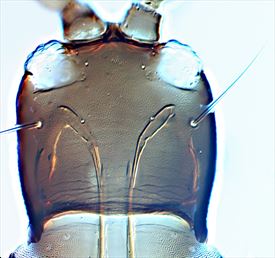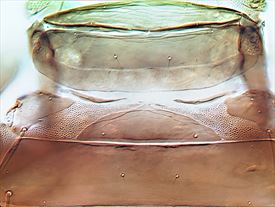Distinguishing features
Both sexes apterous. Female brown; antennal segments II and III, tarsi, apex of tibiae, and apex of tube paler. Head with faint lines of sculpture basally; compound eyes narrowly extended ventrally, cheeks extend around eyes laterally; ocelli absent; postocular setae finely acute, wide apart; maxillary stylets close together, retracted to compound eyes. Antennal segment III smaller than either II or IV; segment VIII with a small but distinct pedicel; segment III lacking sense cones, segment IV with 2 long, slim sense cones. Pronotum lacking sculpture; epimeral sutures incomplete; anteroangular setae minute; anteromarginal setae often short, other major setae longer and finely acute; basantra small, concealed by mouth cone. Mesonotum transverse, with minute setae laterally; metanotum transverse, lacking sculpture, with a pair of median acute setae. Mesopresternum reduced to 2 lateral triangles; metathoracic sternopleural sutures absent. Fore tarsal tooth absent. Pelta broad, with a faint line of sculpture anteriorly; tergites II–VII each with 1 pair of minute, straight wing-retaining setae; sternites with few (1–4) or no discal setae; tergite IX posteromarginal setae S1 finely acute, longer than tube.
Male similar to female, pronotal anteromarginal setae shorter; tergite IX posteromarginal setae S2 shorter, stout; sternite VIII with no pore plate.
Related species
The genus Lissothrips comprises 23 species, of which 12 are known only from the Americas, one from Fiji, one from Japan, eight from Australia, and three from New Zealand (of which two are shared with Australia). Apart from its reduced basantra, L. gersoni appears to be a typical member of Lissothrips, with antennal segment III very small and VIII slender. The pronotal anteromarginal setae are highly variable in length in the type series, and similar variation occurs between specimens in other series, the length of these setae even being bilaterally asymmetric in several individuals.
Biological data
This thrips has been reared on a moss of the genus Thuidum (Mound & Walker, 1986)
Distribution data
Although described from New Zealand (ND, AK, BP, TK, WN / SD, MC), one male of this species is recorded from Queensland, Australia; previous records from Australia were subsequently considered misidentifications (Mound & Tree, 2015).
Family name
PHLAEOTHRIPIDAE, PHLAEOTHRIPINAE
Species name
Lissothrips gersoni Mound & Walker
Original name and synonyms
Lissothrips gersoni Mound & Walker, 1986: 68
References
Mound LA & Tree DJ (2015) The genus Lissothrips from mosses and lichens in Australia and New Zealand (Thysanoptera, Phlaeothripinae) Zootaxa 3946 (3): 361–373.
Mound LA & Walker AK (1986) Tubulifera (Insecta: Thysanoptera). Fauna of New Zealand 10: 1–140.



